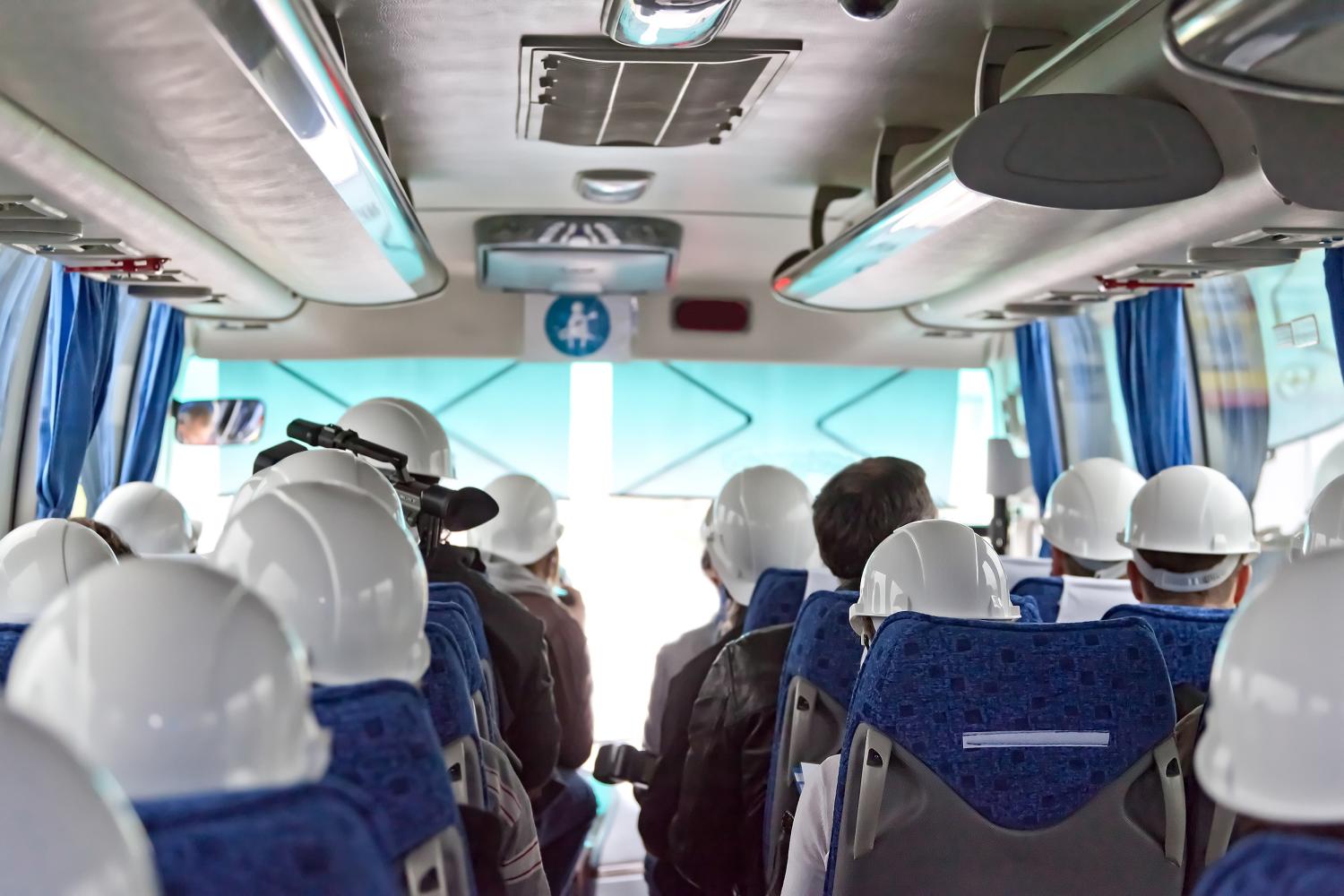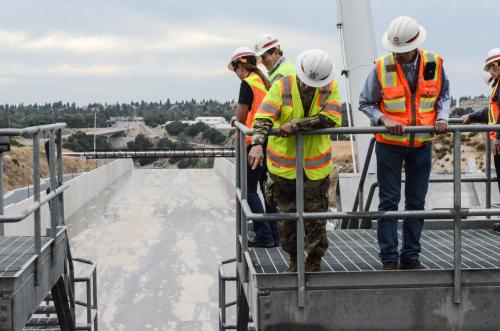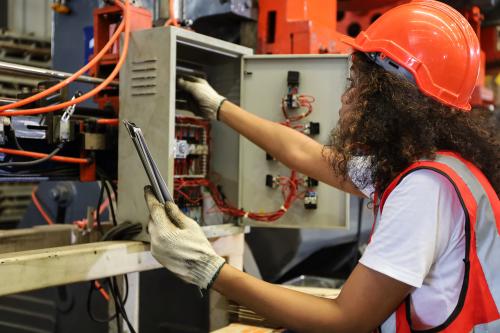The need to hire and train a new generation of workers to construct, operate, and maintain the country’s infrastructure systems represents a pressing challenge in years to come. A wave of retirements, a lack of visibility, and a struggle to create a strong training pipeline have all contributed to a widening talent gap in the infrastructure sector. However, the emergence of “infrastructure academies”— institutions focused on infrastructure workforce development—offers a promising approach to connect more workers with opportunities in this space.
This brief aims to better define what “academies” mean in theory and practice, while examining why employers, educators, and other community leaders may want to establish them as part of a more comprehensive infrastructure workforce strategy. It highlights the evolving role and major limitations of infrastructure academies, before outlining several ingredients essential to their successful design and implementation. To prepare workers for long-lasting infrastructure careers and achieve greater economic opportunity, regional leaders need to consider whether infrastructure academies contribute to a more visible, proactive sector strategy.
Addressing the infrastructure workforce gap
Although the U.S. labor market continues to pick up steam—recently recording its 96th consecutive month of job growth—many workers still struggle to benefit from these gains. Economic inequality remains stubbornly persistent in many areas across the country, particularly for workers who lack higher levels of education and encounter barriers to better pay and opportunity. The prospect of automation and demand for new and emerging skillsets are also areas of concern for many workers.
There is not only a need for stable jobs, but also long-term career pathways for all kinds of workers in support of more enduring economic growth.
While many industries are hiring, few offer the type of accessible and equitable opportunities evident in the infrastructure space. As past Brookings research has shown, there are more than 14.5 million infrastructure workers across the country—employed in transit agencies, water utilities, and multiple other facilities—who earn more competitive wages and face lower educational barriers to entry. At the same time, many of these workers are eligible for retirement, so there is an urgent need to hire, train, and retain younger and more diverse talent, particularly for positions in the skilled trades.
Filling this infrastructure workforce gap holds tremendous economic promise; every region depends on reliable roads, pipes, and other infrastructure systems, and the workers who oversee these assets develop transferable skills and gain valuable experience over time. Even though infrastructure can vary widely in its functional design and operation, the workers across different subsectors depend on many common skills to carry out their jobs, including an emphasis on engineering, design, and mechanical knowledge. The physical systems may look different, but the nature of the work is often similar.
The public sector plays a central role helping infrastructure workers develop these shared skills. There are many infrastructure employers who directly manage personnel recruitment and training across multiple publicly-owned and operated facilities. Public schools, including colleges and universities, prepare students for their professional futures. Workforce development boards are instrumental in guiding regional workforce priorities and resources. Critically, local governments also focus on promoting economic opportunity in the most disadvantaged communities—many of which include major ports, plants, and similar facilities that serve as key local economic anchors for jobs and training.
Yet to maximize the effectiveness of workforce preparation, regional leaders across different sectors—not just public, but also private employers, labor groups, and other community organizations—need to collaborate more effectively.
Ideally, these collaborations should not only recognize the importance of this workforce, but they should also focus on action, centered on clearer channels of communication, more extensive community engagement, more strategic pooling of resources, and stronger training platforms. This is especially important in a sector as siloed and uncoordinated as infrastructure, where employers frequently compete against one another for scarce talent, tend to develop training programs in isolation, and look to avoid unneeded public attention (from regulators and others) while carrying out their work.
Infrastructure academies represent a new type of training platform emerging in some places to bridge these gaps and provide greater visibility to the opportunity at hand, but what are they exactly? And how do they fit into a broader regional approach needed to connect workers with careers in the infrastructure sector?
Defining infrastructure academies
Infrastructure academies serve as secondary and post-secondary educational institutions aimed at introducing more students and prospective job seekers to infrastructure careers through targeted coursework and applied learning opportunities. They are structured to serve as a single destination for workers, employers, and educators to drive more coordinated infrastructure workforce development. With screening, training, and recruitment centered in one physical building, workers can quickly gain knowledge and experience connected to positions offered by specific infrastructure employers in their region. Local governments partner directly with educators, transit agencies, utilities, and other employers to help workers—especially non-traditional candidates like the out-of-work and at-risk youth—develop occupational skills, acquire needed licenses, and gain other competencies.
For example, last March, Mayor Muriel Bowser launched the D.C. Infrastructure Academy (DCIA) as part of a new workforce development effort between the city and several public and private partners, including Pepco, Washington Gas, D.C. Water, and the Washington Metropolitan Area Transit Authority. Located in the city’s historically disadvantaged Ward 8, the DCIA fills what was once a vacant elementary school, and provides a space for training and education overseen by the Department of Employment Services. Likewise, last June, Los Angeles County and LA Metro announced a similar effort dubbed “Transportation School,” which aims to introduce and prepare students for careers in transportation. As part of a new development in South Los Angeles, the Transportation School complements other existing workforce initiatives to connect local workers with local hiring needs.
In turn, infrastructure academies can serve workers and employers across many different infrastructure subsectors like transportation, water, and energy—as is the case in D.C.—but can also focus on one subsector like transportation—as is the case in Los Angeles. Whether they’re called “academies” or “schools,” their role is still evolving, and their ability to better coordinate hiring and training across one subsector—let alone the entire infrastructure supersector—remains up in the air.
Infrastructure academies aim to further elevate the reach of these efforts by serving as a consolidated entry point.
Infrastructure academies represent a next step in many ways to existing infrastructure workforce development efforts; however, based on the few examples that exist, their novel contribution is their ability to provide a single regional destination for employers and educators to concentrate future hiring and training efforts. After all, several individual infrastructure employers might already partner with community colleges and other local training providers in their regions, but infrastructure academies aim to further elevate the reach of these efforts by serving as a consolidated entry point. For instance, infrastructure academies would build off existing efforts (like Georgia’s logistics workforce initiative and other innovative utility-led workforce initiatives in California’s Bay Area and elsewhere) by representing a more visible destination for training and recruitment, while coordinating activities among different agencies and organizations.
Considering the limitations of infrastructure academies
Infrastructure academies embody a movement toward greater regional experimentation and collaboration, but their potential remains unclear.
Since these academies are so new, it’s difficult to quantify their local impact: from the number of workers they’re reaching and the number of “graduates” they’re helping, to the number of jobs they’re ultimately filling. It’s also difficult to say whether the programs and partnerships behind them are truly sustainable, financially or otherwise. After all, the formation of DCIA received a boost from a $5.2 million contribution as part of the recent Exelon-Pepco merger, but ongoing operational needs might demand additional public and private support. And while the political appeal of these academies is obvious now—much like a ribbon-cutting ceremony at a new bridge—it’s difficult to envision whether future leaders will prioritize them in the same way.
The lack of a cohesive infrastructure workforce strategy in many regions is another complicating factor for infrastructure academies. Indeed, sector strategies help employers and educators highlight industry priorities, define credentials, and encourage work-based learning opportunities, as evident in the health care and manufacturing sectors, for instance. Yet, many of the biggest infrastructure actors, from utilities to ports, act in silos and do not collaborate—let alone talk with one another—even though they are part of a supersector that shares many commonalities. Even within individual infrastructure subsectors like water or transportation, employers may rarely meet or discuss how they can support (and benefit from) a bigger, common pool of skilled labor. This disconnect is a huge problem for a workforce that requires higher levels of on-the-job training and work experience where it’s crucial that employers are actively and cooperatively engaged in training efforts.
Many of the biggest infrastructure actors, from utilities to ports, act in silos and do not collaborate—let alone talk with one another—even though they are part of a supersector that shares many commonalities.
While infrastructure academies could bring greater focus and attention to the infrastructure workforce—ideally across the whole supersector, but even within individual subsectors—simply offering training in one building cannot overcome a lack of coordination and planning at a regional scale.
Finally, there are limitations to creating a cohesive infrastructure workforce approach given some of the specialized activities and hiring needs of individual employers. For instance, the lack of portable, versatile credentials is a challenge among many workers and employers in the skilled trades, and infrastructure academies are not going to solve this issue alone. Moreover, union apprenticeship and pre-apprenticeship programs may already have training spaces that facilitate much of what infrastructure academies could provide, and regions may be able to better leverage financial resources for these existing spaces instead. Put simply, infrastructure academies may be able to promote additional training, but they cannot mean all things to all occupations and there are open questions on how they can best complement existing efforts.
Examining pathways to implementing infrastructure academies
Infrastructure academies may help encourage collaboration and prepare workers for careers in this space. But establishing an infrastructure academy means little without considering their role as part of a larger workforce development ecosystem. And that requires viewing their role alongside broader trends, challenges, and opportunities in infrastructure workforce development, both within individual subsectors and across the whole supersector.
So how can these academies bolster their position and contribute to a longer-term strategy that can reach more workers in more places?
Ultimately, the success of infrastructure academies depends on regional planning and action. While individual infrastructure employers are pioneering new hiring practices and training platforms, regional leaders should more intentionally collaborate and elevate communication across multiple employers, educators, and other entities. Infrastructure academies offer one possible way to do that through better metrics, accounting, and monitoring.
Pursuing any expanded workforce development efforts must reflect a region’s broader interests.
Federal and state leaders could help provide additional financial and technical resources to guide the development of these academies—in much the same way the U.S. Department of Labor, Department of Transportation, and Environmental Protection Agency do through related workforce grant programs—but regional leaders are best attuned to the workforce demands of their markets. The potential design and implementation of any academies would ideally consider several key regional elements:
- Programming and resource coordination: Regional leaders must balance a number of different programmatic responsibilities, including other workforce priorities, so it is essential that they view any infrastructure workforce development efforts in light of existing policies and programs. Linking training efforts to particular infrastructure projects and hiring needs, for instance, would likely create a clearer timeline for employers, educators, and workers alike when deploying scarce technical and financial resources.
- Scale: Regions vary widely in the size and type of infrastructure facilities (and employers) present, including those that straddle multiple jurisdictions. In order to equip workers with the skills and certifications they need—and connect them to the specific employment opportunities that are available—regional leaders need to determine an appropriate geographic scale for any training efforts, ideally in concert with other community partners. For instance, in larger metro areas, it may only be institutionally and economically feasible to collaborate with a limited number of infrastructure employers. In smaller communities, it may be possible to realize greater economies of scale by collaborating with employers across a broader region.
- Community buy-in: The success of an infrastructure academy depends on workers and employers, in particular, viewing the training as mutually beneficial. Therefore, regional efforts must engage these parties closely as an academy is in development. Ensuring that political leadership believes in (and is invested in) infrastructure workforce development is one matter, but it’s perhaps even more crucial that a broad collection of infrastructure employers are committed to these efforts as well. Programmatically and financially, employers only have so many resources to allocate beyond their other operational and capital needs, and some employers like utilities might need to make the case to their ratepayers as well. As such, pursuing any expanded workforce development efforts must reflect a region’s broader interests, not only to support more efficient and reliable infrastructure operations, but also to ensure employers hire graduates of the academy and residents want to enroll in it.
- Physical location: If regional leaders are looking to create an outlet for additional training—especially for non-traditional candidates who may not have the resources to reach employers or other educational opportunities—it’s key that the facility is readily accessible. This means that prospective workers and students have transit and other services available that make reaching an academy convenient, reliable, and affordable.
- Durability: For an infrastructure academy to play a significant role in the development of a local economy, the academy needs to have long-term viability. Put another way, it needs to not only focus on filling immediate vacancies, but also provide long-term career prospects for graduates. In addition, stakeholders must consider how best to secure ongoing funding for the academy. Having an organizational intermediary or specific government department handle these tasks could spearhead ongoing planning activities among partners, organize job fairs, and represent a common point of contact as any other technical issues arise over time.
Infrastructure academies are just one part of an emerging workforce development priority in many regions. As employers, educators, and other leaders look to fill positions of greatest need, they are experimenting with a variety of different approaches—including better branding, more flexible hiring practices, and expanded training programs—to reach more students, workers, and other potential candidates. The ability of academies to accelerate these efforts within individual infrastructure subsectors and across the entire infrastructure supersector remains to be seen, but their success or failure is worth watching. At the very least, this new model should provide lessons for regions looking to address their infrastructure challenges and connect workers with sustained economic opportunity.








